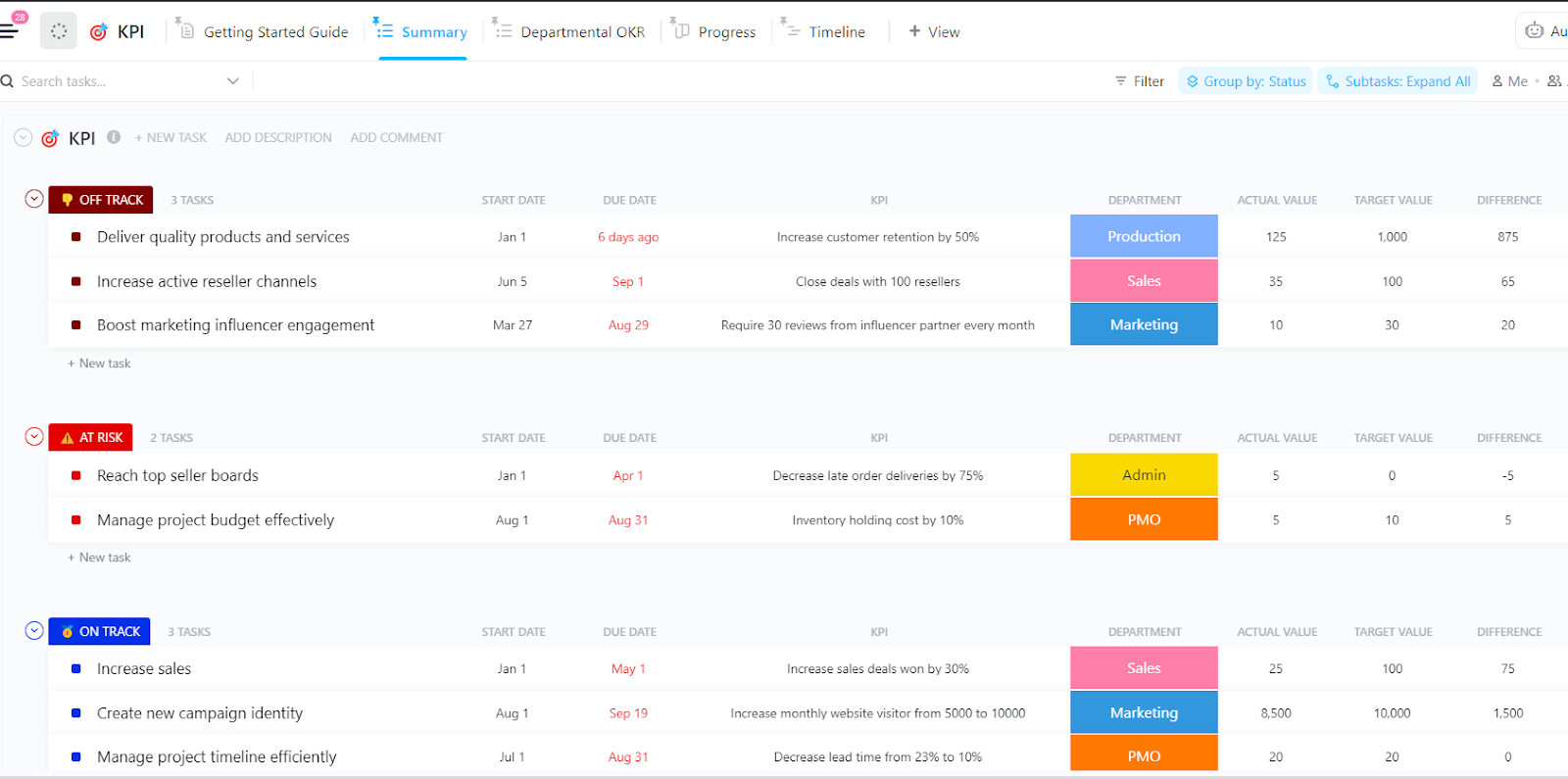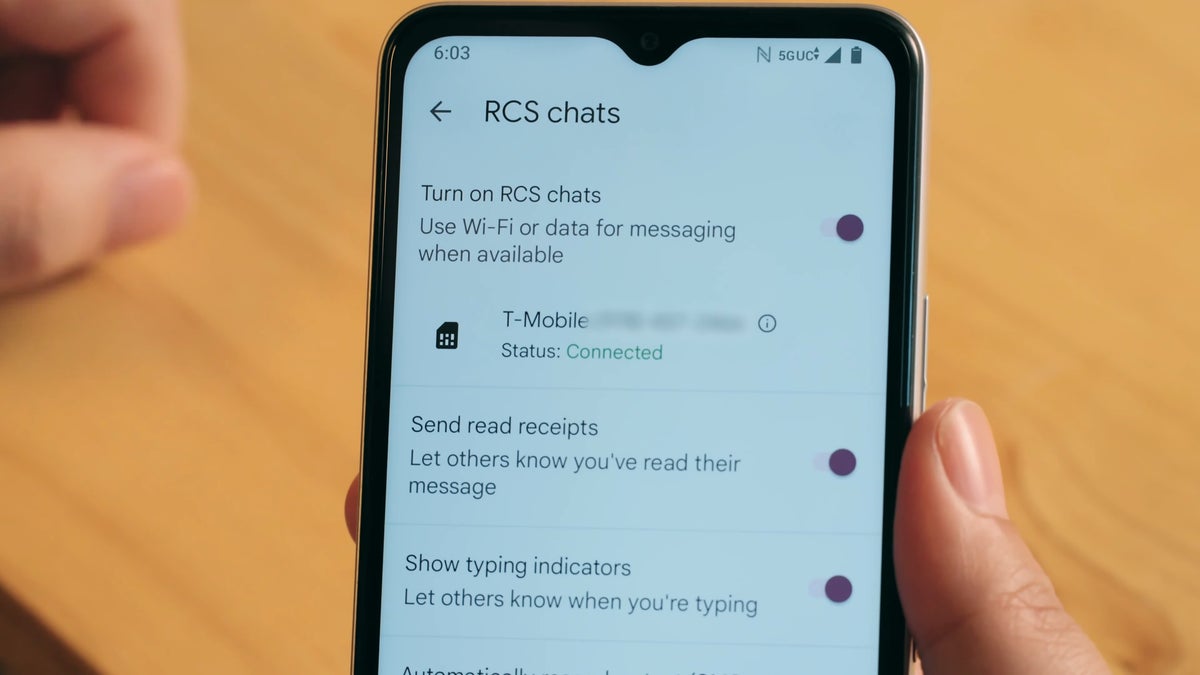Organizations today constantly face transformation challenges—implementing new technology, restructuring teams, or adapting to market shifts. Most of these fail because of poor measurement and tracking.
Without clear metrics, leaders navigate complex organizational changes blindfolded. Change is hard, but without the right metrics, even the best intentions can unravel. Tracking the right KPIs is what makes change stick.
In this blog post, we’ll explore 15 powerful key performance indicators (KPIs) that turn organizational transformation into a strategic advantage. 🎯
⚡️ As a bonus, we’ll also introduce you to how you can set and monitor your change management KPIs with and use ready-to-go, free templates to ensure every change management initiative is a success
Top 15 Change Management KPIs and Metrics to Track
15 Key Change Management KPIs to Track
Tracking the right change management metrics helps you stay ahead of potential roadblocks and make informed decisions at every stage of the change control process.
But it can be hard when your change management indicators are spread across multiple tools and applications.
📮 Insight: Context-switching is silently eating away at your team’s productivity. Our research shows that 42% of disruptions at work come from juggling platforms, managing emails, and jumping between meetings. What if you could eliminate these costly interruptions?
unites your workflows (and chat) under a single, streamlined platform. Launch and manage your tasks from across chat, docs, whiteboards, and more—while AI-powered features keep the context connected, searchable, and manageable!
Here are 15 key change management KPIs to help you gauge progress, address challenges, and drive meaningful results. 📊
1. Adoption rate
Adoption rates show the percentage of employees who have started using the new process, system, or tool. A high adoption rate indicates successful communication and training, while a low rate may signal resistance or gaps in understanding.
Use system logins, feature usage analytics, and survey responses to measure adoption levels and identify areas for improvement.
📌 Example: A company introduces new project management software, but only 40% of employees actively use it after three months. Leadership may need to improve training or address concerns about slowing adoption.
2. Rejection rate
Not everyone will embrace change immediately. The rejection rate tracks the percentage of employees resisting or avoiding the new system. A rising rejection rate suggests deeper issues, such as poor communication or a lack of involvement in decision-making.
Analyze feedback from surveys, support tickets, and direct conversations to understand objections and refine the change approach.
📌 Example: A new company policy receives pushback from 30% of employees. So, the company gathers feedback to identify concerns and guide necessary adjustments.
3. Time to adoption
Time to adoption measures how long it takes employees to fully integrate the change into their workflow. Faster adoption indicates effective support, while delays point to challenges in training, system usability, or leadership alignment.
Track onboarding completion, frequency of use, and workflow integration to assess how quickly the change takes effect.
📌 Example: A team takes six months instead of the expected three to transition to a new customer relationship management (CRM) system. This KPI example encourages you to review the onboarding processes that can help accelerate the shift.
4. Backed-out changes rate
Sometimes, changes are reversed due to unforeseen issues or negative feedback. Backed-out changes rate tracks how often that happens and why. A high rate suggests a lack of thorough testing, inadequate training, or misalignment with employee needs.
Calculate the percentage of implemented changes reversed due to issues, resistance, or poor adoption. Analyzing root causes, such as inadequate training or technical problems, helps refine future change strategies.
📌 Example: An organization rolls out a new approval workflow and reverts to the old process within weeks. The change reversal happened after analyzing user feedback, highlighting pain points, and informing about improvements.
🧠 Fun Fact: The idea that ‘Change is the only constant’ is attributed to the Greek philosopher Heraclitus. He believed that change was a fundamental aspect of reality and that everything was constantly in flux.
5. Employee engagement level
Engaged employees are more likely to support and sustain change. This metric assesses participation in training sessions, discussions, and feedback loops. Metrics like intranet activity, team meetings, and sentiment analysis can indicate enthusiasm and buy-in.
A drop in engagement signals potential resistance or unclear communication.
📌 Example: If clients are not actively using the portal despite onboarding efforts, analyzing feedback, simplifying navigation, and offering personalized tutorials can enhance adoption.
6. Productivity impact
Tracking how change affects productivity helps determine whether employees adapt smoothly or face disruptions. A temporary dip is normal, but prolonged inefficiencies indicate a need for better training or process improvements.
Compare key performance metrics like output, task completion, and error rates before and after implementation. Use time-tracking tools, project management reports, and employee feedback to determine if the change enhances or hinders productivity.
📌 Example: If a new reporting tool increases time spent on routine tasks, refining workflows or automating specific steps can ease the transition.
7. Compliance rate
This metric measures adherence to your change initiative’s new policies, procedures, or regulations. A low compliance rate often suggests that employees either don’t understand the change or find it too difficult to follow.
Track adherence to new policies, procedures, or systems through audit reports, system logs, and employee self-assessments. Identify gaps early and reinforce training or support to improve compliance levels.
📌 Example: If only 60% of employees follow a new security protocol, additional training and clearer communication may improve compliance.
🔍 Did You Know? According to a study by Gartner, about 50% of change initiatives fail, and only 34% achieve clear, measurable success.
8. Customer satisfaction
Change doesn’t only impact internal teams. Monitoring customer feedback before and after implementation helps gauge whether the shift improves service quality or causes disruptions.
Here are some aspects to track:
- Customer Satisfaction Score (CSAT)
- Net Promoter Score (NPS)
- Customer Effort Score (CES)
- Online customer reviews and ratings, and social media listening
- Support ticket analysis
📌 Example: If complaints increase after a customer service workflow change, reviewing processes and addressing concerns can prevent long-term dissatisfaction.
9. Training completion rate
Training plays a crucial role in change management success. Tracking the percentage of employees who complete required training sessions provides insight into overall preparedness.
Monitor attendance logs, learning management system (LMS) reports, and quiz completion data to assess participation. Use automated reminders, progress dashboards, and post-training surveys to identify drop-off points and improve engagement.
📌 Example: If only half of the workforce completes training on a new tool, improving accessibility or breaking sessions into smaller modules may increase participation.
10. System performance
When implementing new software or digital tools, you must monitor system performance. Frequent crashes, slow response times, or integration issues can frustrate employees and slow adoption.
Monitor uptime, response times, error rates, and system logs to assess the stability and efficiency of new software or processes. Use performance dashboards, and IT support tickets to track technical issues and improvements.
📌 Example: If a new HR system experiences frequent downtime, IT teams may need to address technical issues before expecting widespread adoption.
11. Communication effectiveness
Effective communication ensures that employees understand the change, its purpose, and their role in the transition.
Evaluate message clarity and reach through employee surveys, intranet engagement, and meeting participation. Track response rates, feedback loops, and alignment between leadership messaging and employee understanding.
📌 Example: If employees frequently ask the same questions about a change, messaging may need to be adjusted for clarity.
12. Leadership support
Strong leadership drives successful change. This metric assesses how actively leaders promote and reinforce the initiative. Visible support from leadership increases trust and reduces resistance.
Measure executive and managerial involvement through participation in change initiatives, visibility in meetings, and endorsement of key messages. Employee sentiment surveys and leadership-driven engagement metrics can indicate effectiveness.
📌 Example: If managers rarely mention the change in team meetings, additional leadership engagement may be necessary to boost alignment.
13. Cost vs. benefit analysis
Measuring the financial impact of a change helps determine if the benefits outweigh the costs. This includes tracking expenses for training, software, and lost productivity during the transition.
Compare implementation costs (training, tools, resources) against measurable benefits like productivity gains, revenue growth, or cost savings. Track financial reports, operational metrics, and ROI assessments over time.
📌 Example: If a new workflow saves two hours per employee each week but requires extensive retraining, comparing these factors helps assess long-term value.
14. Employee feedback
Collect insights through pulse surveys, suggestion boxes, focus groups, and performance reviews. Analyzing sentiment trends, common concerns, and suggestions helps refine change strategies.
📌 Example: If employees express confusion about new expectations, refining training materials or providing additional support can address concerns.
🔍 Did You Know? About 27% of employees say their employer rarely or never asked for their feedback on changes made during the pandemic.
15. Change sustainability
Tracking whether the change remains effective over time ensures long-term success. This includes measuring adoption rates months after implementation and identifying signs of reverting to old habits.
Assess long-term adoption by tracking continued usage rates, employee adherence, and process integration over time. Regular check-ins, audits, and follow-up training can ensure lasting success.
📌 Example: If employees stop using a new tool after initially being enthusiastic about it, reinforcing its benefits and offering ongoing support can sustain momentum.
🔍 Did You Know? Mistrust in the organization is the biggest obstacle to change, with 41% of employees resisting it. Other common concerns include not understanding why the change is happening (39%), uncertainty about the future (38%), shifts in job roles (27%), and feeling left out of decision-making (23%).
Developing Effective Change Management KPIs
Tracking the right KPIs ensures that change initiatives stay on course and deliver meaningful results. However, effective KPIs don’t happen by chance—they require strategic planning, clear goals, and a structured approach to measuring organizational performance.
, the everything app for work, simplifies KPI development and tracking with its powerful goal-setting, reporting, and dashboard features. It provides a centralized platform where teams can define key metrics, monitor real-time progress, and adjust strategies based on actionable insights.
Here’s how to develop change management KPIs using . ⚒️
Set benchmarks and define goals with Goals
Before tracking progress, teams need a clear starting point and a destination.
Benchmarking helps compare current performance against industry standards or internal baselines, while goal-setting provides a roadmap for success.

Goals allow you to define measurable objectives and track progress in one place. You can break down Goals into Targets, which are specific milestones that help measure progress over time.
Teams can set numerical, monetary, or true/false Targets, making it easy to track everything from adoption rates to training completion percentages.
For instance, a company rolling out a new internal communication tool can create a Goal titled ‘Increase adoption of the new messaging platform.’ Targets might include ‘75% of employees actively using the tool within three months’ and ‘90% completion rate for training sessions.’
Categorize KPIs by impact using Custom Fields and Tags
Not all KPIs carry the same weight.
Some directly influence the success of a change initiative, while others provide supporting insights. Identifying the key areas impacted by the change—such as employee adoption, productivity, or customer satisfaction—helps prioritize the most relevant KPIs.
’s flexible workspace structure with Tasks allows teams to categorize KPIs based on their impact. Tasks are the foundation for organizing and managing work, allowing teams to break down projects into actionable steps. You can also add detailed descriptions, assignees, priorities, due dates, and dependencies.


Add Custom Fields and Task Tags to tasks for easy filtering and data analysis specific to adoption, engagement, or performance improvements.
For instance, if a company introduces a new project management methodology, they can organize KPIs under categories like ‘Task Completion Rate,’ ‘Meeting Efficiency,’ and ‘Time Spent on Rework.’ Custom Fields can capture numerical values, qualitative feedback, or internal historical data related to these areas.
Make KPIs measurable and actionable with smart targets
Vague KPIs lead to confusion and ineffective tracking. Each metric should have a clear definition, a quantifiable measurement, and a direct connection to decision-making.
📌 Example: Instead of a broad KPI like ‘Improve employee engagement,’ a more effective metric would be ‘Increase employee survey participation from 60% to 80% within six months.’ This clarifies what success looks like and provides a timeframe for evaluation.
Setting thresholds for KPIs further enhances change management effectiveness. Metrics should include target values, acceptable performance ranges, and benchmarks for comparison.
📌 Example: If a change initiative aims to reduce customer support resolution times, a strong KPI might specify ‘Decrease average resolution time from 48 hours to 24 hours while maintaining a customer satisfaction score above 85%.’ This ensures that speed improvements don’t come at the cost of service quality.
💡 Pro Tip: Recognize that successful change begins with the individual. Use models like Prosci’s ADKAR to equip change managers with practical tools and strategies for engaging team members.
Track real-time progress using Dashboards
Tracking KPIs requires a structured approach to data collection and reporting. Without a centralized system, valuable insights can be lost in scattered spreadsheets or disconnected reports.


Dashboards are customizable, centralized reporting hubs where teams can track real-time KPI performance. Using pre-built cards, you can create reports, automate data updates, and share insights across teams.
The platform also syncs with third-party tools through Integrations, ensuring seamless data consolidation from multiple sources.
For example, a company measuring the impact of a new employee onboarding process can set up a KPI dashboard displaying training completion rates, employee feedback scores, and the average time it takes to reach full productivity. This allows HR teams to identify gaps and improve the onboarding experience quickly.
Review and refine KPIs over time
KPIs should not remain static. Regular reviews help refine metrics, eliminate unnecessary tracking, and adjust goals based on new insights. As business priorities shift and new challenges emerge, some KPIs may become less relevant, while others need to be introduced.
Reviewing KPIs at scheduled intervals ensures they continue to align with organizational objectives. Teams should assess whether each metric still provides meaningful insights or adjustments are necessary.
For example, a company initially tracking software adoption rates might shift its focus to user proficiency and efficiency once the tool is widely adopted.
💡 Pro Tip: Performance trends over time can also highlight the need for refinements. If a KPI consistently exceeds its target, it may indicate that the goal was too low and should be adjusted to drive further improvement. On the other hand, if a metric frequently falls short, teams may need to reevaluate strategies, manage additional resources, or redefine success criteria.
Leveraging Technology in Change Management: Implement, Track, and Analyze
Technology is key in streamlining change management processes, ensuring teams stay organized, track progress, and make data-driven decisions.
Let’s look at some features offers to manage change initiatives efficiently. 📝
Automate change management workflows


Automations simplifies repetitive tasks, ensuring smooth transitions during change initiatives. You can automate actions like assigning tasks, updating statuses, and sending notifications based on custom triggers. This reduces manual effort and keeps everyone aligned on the next steps.
For example, when a change request is approved, custom automation creates training session tasks and notifies relevant team members.
🤝 Friendly Reminder: Organizations don’t change—people do. Tailor your change management strategies to address individual concerns and needs to ensure everyone understands their role in the transition.
Visualize data with Dashboards
Tracking KPIs and performance metrics becomes easier with Dashboards.
Teams can customize dashboards with charts and reports to monitor adoption rates, completion percentages, and other key indicators.
For instance, if a company is rolling out a new software system, a custom dashboard can display real-time data on user adoption, common roadblocks, and support requests. This allows managers to identify trends and take action before issues escalate.
Track performance with goals and milestones
Goals help teams set measurable targets and track progress in real time. Each goal can include key results, due dates, and assigned owners, ensuring accountability throughout the change process.


Milestones provide a structured way to mark significant achievements. Teams can create benchmarks to track major phases of a transition, such as policy updates, training completion, or full adoption of a new process.
For instance, a company implementing a new remote work policy can use Milestones to track key transition phases. They set milestones for finalizing policy guidelines, completing employee training, and achieving full remote adoption.
⚙️ Bonus: Try goal-setting templates to ensure every goal aligns with broader change management initiatives.
Use Templates for a structured approach
offers over 1,000 pre-built templates for different use cases. Let’s look at some change management templates you can use to execute initiatives effortlessly.
1. Change Management Checklist Template
The Change Management Checklist Template guides you in identifying change objectives, outlining relevant processes and protocols, and setting clear goals. This template helps you prepare teams for transition and allows you to track progress through each process step for timely change implementation.
The template also outlines key processes tailored to your change—a new policy, a procedural shift, or a significant organizational change. This customization ensures that your approach fits the exact needs of the transition.
🤝 Friendly Reminder: Prepare and support managers and supervisors who face organizational change. Their active involvement can significantly influence the success of the change initiative.
2. KPI Template
The KPI Template organizes data to help you quickly see how your team is progressing toward specific goals. Ensure everyone is aligned around objectives and track performance over time with visually engaging visuals.
Like other templates, it offers multiple views to suit different needs. The Summary View provides a broad overview of all KPIs, while the Departmental OKR View focuses on specific objectives and results for each team. This versatility ensures key stakeholders get the information they need.
📌 You can also use the Change Management Simple Plan Template for a simplified change management plan.
Enhancing Employee Engagement and Satisfaction
Engaged employees contribute more, stay longer, and foster a positive workplace culture. provides structured change management tools to support engagement from day one and throughout an employee’s journey.
Here are some employee engagement and satisfaction strategies:
Set the stage for success during onboarding
A structured onboarding process helps new hires integrate smoothly into the company. Without a transparent system, employees may feel overwhelmed, leading to disengagement or early turnover.
Successful onboarding includes:
- A step-by-step checklist covering essential tasks such as IT setup, policy reviews, and team introductions
- A dedicated mentor or buddy to answer questions and provide guidance
- Structured training sessions that introduce company culture, expectations, and role-specific responsibilities
For example, a marketing agency can implement an onboarding program with a scheduled introduction to branding guidelines, content strategy, and collaboration tools. A well-organized process ensures employees feel confident and productive from day one.


Task Checklists ensure every new hire follows a structured onboarding process. HR teams can create a checklist that includes IT setup, HR paperwork, and role-specific training. Each task can have due dates, attachments, and assignees, ensuring nothing is missed.
For instance, a marketing agency uses Task Checklists to onboard new content writers. The checklist includes setting up email accounts, accessing content guidelines, completing SEO training, and submitting the first draft.
💡 Pro Tip: Adopt rapid, hyper-innovation cycles to stay ahead in dynamic markets. This approach can lead to better and faster idea generation, keeping your organization competitive.
Keep employees informed and engaged
Employees feel engaged when included in company discussions, goals, and updates. Without clear communication channels, teams struggle with missed information and misalignment.
Ways to improve communication include:
- Organize regular check-ins and company-wide meetings, or town halls
- Maintain a centralized hub for announcements and important updates
- Encourage two-way communication for candid employee feedback
For example, a remote software development team benefits from a centralized communication platform where discussions, files, and updates are consolidated. This prevents information loss and ensures everyone stays aligned.


Chat integrates real-time discussions directly into the workspace. Unlike external collaboration apps, Chat links conversations, tasks, and projects, reducing the need to switch between platforms.
Here are some other features you can use:
- AI CatchUp: Summarize missed messages so employees can quickly get up to speed
- FollowUps™: Ensure action items from conversations don’t get lost
- Connected Tasks: Link discussions to relevant tasks, so nothing is overlooked
- SyncUps: Enable audio and video calls for instant collaboration
Drive engagement through clear leadership
Clear leadership and well-defined roles reduce ambiguity and foster engagement. Employees perform better when they know what’s expected of them and how they fit into the bigger picture.
For example, a product development team working on a feature update can improve efficiency by assigning clear ownership of tasks and setting deadlines for each stage.


Assign Comments allows managers to provide feedback directly within tasks. Instead of sending emails or chat messages that may be missed, change leaders can assign a comment to a specific person, ensuring accountability.
With this async communication tool, you can:
- Eliminate confusion by linking feedback directly to tasks
- Ensure action items are addressed without extra follow-ups
- Keep discussions organized and contextually relevant
For instance, if a designer submits a draft, a manager can leave a comment requesting revisions and assign it to the designer. The designer receives a notification and can respond to it within the Task.
💡 Pro Tip: Encourage employees to experiment and propose new ideas without fear of failure. This openness can lead to innovative solutions during transitions.
KPI-n It Real With
Change management isn’t complex. With the right KPIs and tools, you can turn organizational shifts into opportunities for growth and innovation. Tracking metrics like adoption rates, employee engagement, and productivity impact ensures you’re making successful changes.
But let’s be honest: managing all these metrics can be overwhelming without proper support.
That’s where comes in. From customizable Dashboards to automated workflows with Automations, it becomes an all-in-one solution for seamless change management.
Whether you’re rolling out new software, restructuring teams, or adapting to market trends, keeps your team aligned, informed, and on track.
Sign up to for free today! ✅


Everything you need to stay organized and get work done.















